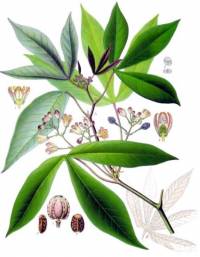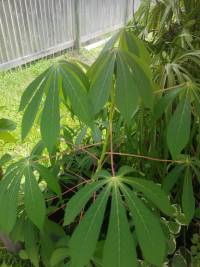This is an old revision of the document!
Cassava
Botanical Information
| Botanical Information | |
|---|---|
| Order | Malpighiales |
| Family | Euphorbiaceae |
| Genus | Manihot |
| Common Name | Cassava |
| Species | M. esculenta |
Maturity days
- 210
Planting Months
| Planting months | |||||||||||
|---|---|---|---|---|---|---|---|---|---|---|---|
| Jan | Feb | Mar | Apr | May | Jun | Jul | Aug | Sep | Oct | Nov | Dec |
| X | X | X | X | X | X | X | X | X | X | X | X |
Permaculture uses
| Permaculture uses | ||
|---|---|---|
| Usage 1 | Usage 2 | Usage 3 |
| Pioneer | Starch | Vegetable |
Growing condition comments
| Growing Condition | Comment |
|---|---|
| Drought Tolerant | Yes |
| Humidity tolerant | Yes |
| Planting area | Ground |
| Sunlight | Full_sun |
Photos
Short comments
Woody shrub. Tubers/Leaves poisonous. Must be boiled before consumption. Can be used as fencing
General comments
A large, 3-4 m high, tropical woody shrub with enlarged tuberous roots. It tends to branch irregularly and bears its large (20 cm long) lobed leaves near the tips of long branches. The leaves are short-lived (1-3 months) and are readily lost during drought or after insect attack.
Cassava is very hardy and tolerant of a wide range of soils.
Leaves for consumption can be produced throughout the year if the plants receive sufficient water. The portion eaten is generally the maturing leaves that are just reaching full size. Cassava leaves are NOT EATEN RAW, as they contain harmful glucosides which release deadly hydrocyanic acid. To dispel the poison the leaves must be boiled at least 15 minutes.
Cassava leaves contain protein, iron and B vitamins. They are boiled like spinach or added to stews. There are so many useful and easy to grow tropical greens that cassava leaves are not a 'first choice' option. Sweet potato leaves, pumpkin tips, kangkong, ceylon spinach are better alternatives and are easy to eat and prepare.
The roots are more useful as a food plant, they are harvested when the leaves begin to yellow and fall. They are eaten boiled, fried, baked and made into flour. It is important to prepare the roots properly, as they contain the same hydrocyanic acid as the leaves. The refined starch from the tubers, known as tapioca pearls, is used in soups, puddings and dumplings. The roots store well.
Cassava will grow all year in the tropics. Woody cuttings are planted upright in the soil with the sloping end up. Cutting the tops of the cuttings at an angle stops water sitting there and reduces problems with rot. The best cutting material is obtained from plants at least 10 months old, 2.5 to 4 cm thick and about 20 - 30 cm long, with a minimum of 3-6 buds per cutting. The cuttings are buried to half their length, aiming to have several buds under the soil. The cuttings root readily and establish plants within 2 months. Place plants 80 to 140 cm apart.
Preparation
To make sweet cassava safe to eat, first peel the cassava with a knife, and slice the cassava and then cook it thoroughly either by baking, frying, boiling or roasting. This process reduces the cyanogenic glycosides to safe levels. Frozen cassava and frozen peeled cassava should also be cooked in this way. Discard any cooking water after use (https://www.foodstandards.gov.au). Bitter cassava required additional preparation time to remove the cyanogenic glycosides.
Boiling:
- Place the cut and peeled yuca pieces in a pot, cover with cold water, season with salt, and bring to a boil.
- Lower the heat and simmer until tender, about 20 minutes.
- Drain well.
Frying:
The cassava needs to be boiled first and patted dry before it can be fried in hot oil until crisp. Unlike most french fries, the yuca should be cut into thick pieces so the inside stays moist while the outside becomes crispy. For chips, the yuca should be sliced thinly and soaked in ice water before frying.
In a deep, heavy-bottomed pan, heat 2 inches of vegetable oil to a temperature of 180C Add the cassava to the hot oil in batches, making sure not to overcrowd the pot. Fry until golden brown, turning occasionally. Remove and place them on paper towels to drain.


